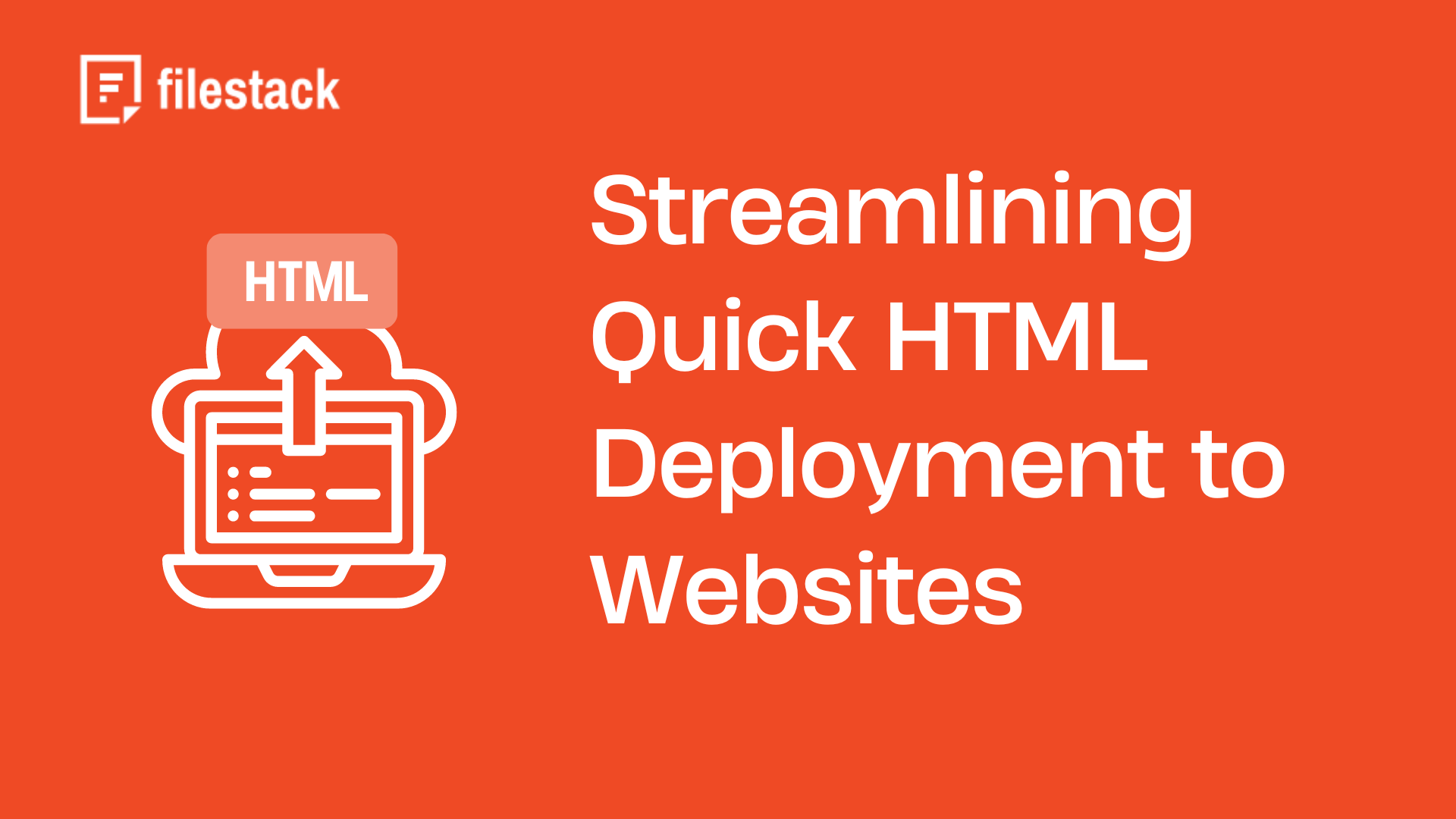Quick HTML deployment to website is crucial for web developers and content creators in today’s fast-paced digital world. It enables developers to quickly create, update, and modify websites without compromising quality. Moreover, by deploying HTML rapidly, developers can make changes according to user demands and feedback, business needs, and market trends in a timely manner. Thus, quick HTML deployment accelerates web development and enhances the user experience, providing a competitive advantage.
When it comes to quick HTML deployment to website, quick file upload capabilities are also crucial. They make it easier to add or replace assets like images, videos, and documents as part of an HTML deployment. This ensures that content updates are deployed as quickly as the HTML itself.
In this comprehensive guide, we’ll cover core concepts of implementing quick and efficient HTML deployment processes for websites.
Understanding Quick Deployment Fundamentals
Version control basics
Version control is a way to track and manage changes to code or files over time. This way, developers can recall specific versions later as needed. Version control is a core part of managing and deploying websites and web apps.
Popular version control systems include:
- Git: Git is a distributed version control system. This means every developer working on a project has a complete copy of the repository.
- SVN: SVN is a centralized version control system. This means all files are stored in a central server, and developers can access them to work on them.
Here is a simple example of basic Git workflow/Git-based website deployment:
git init
git add //Add your project files to the repository
git commit -m "Initial commit" //Commit changes
git checkout -b feature-branch //branch for feature development
git add .git commit -m "Implemented feature XYZ"
git checkout main //swicthing to the main branch
git merge feature-branch //Merging the feature branch into the main branch
git push origin main //Pushing the changes to the remote repositoryContinuous Integration/Continuous Deployment (CI/CD)
CI/CD is a modern software development practice that enables teams to make several changes to a codebase simultaneously. These changes are then tested and deployed automatically. Thus, CI/CD helps deliver code changes more frequently and reliably.
- Continuous Integration (CI): CI involves integrating code changes into a shared repository like Git frequently and automatically. This ensures that new changes don’t break the existing codebase.
- Continuous Deployment (CD): CD involves automatic integration, testing, and delivery of code changes.
Popular CI/CD tools include Jenkins, GitHub Actions, and GitLab CI.
Here’s a simple example of setting up a basic CI/CD pipeline using GitHub Actions:
name: CI/CD Pipeline
# Trigger the workflow on push or pull request events to the main branch
on:
push:
branches: [main]
pull_request:
branches: [main]
jobs:
build:
runs-on: ubuntu-latest
steps:
//Checkout the repository
- name: Checkout code
uses: actions/checkout@v3
- name: Set up Node.js
uses: actions/setup-node@v3
with:
node-version: '16'
- name: Install dependencies
run: npm install
- name: Run tests
run: npm test
- name: Build the project
run: npm run build
//Deploy to production
- name: Deploy
if: github.ref == 'refs/heads/main'
uses: peaceiris/actions-gh-pages@v3
with:
github_token: ${{ secrets.GITHUB_TOKEN }}
publish_dir: ./buildStatic vs. dynamic site considerations
When planning quick deployments, it’s important to first plan whether your site will be static or dynamic.
Static Sites
Static sites consist of HTML files, CSS, and JavaScript files. These website files do not change and developers have to update them manually to make any changes. Key advantages of static website development include fast load times, easy caching, and simpler deployment.
Deployment of static sites usually involves uploading files to a web server or using static site hosting services like GitHub Pages.
Dynamic Sites
Dynamic sites generate content on the server-side. They often use databases and server-side scripting languages like PHP, Python, or Node.js. Building dynamic websites or web pages requires a solid understanding of database management and server configuration.
Moreover, deploying dynamic websites is complex. It involves setting up a server with the necessary backend environment and deploying both the front-end and back-end components.
Setting Up a Deployment Pipeline
Choosing the right deployment tools
Using the right tools is essential for an efficient deployment process. While various tools are available, it’s best to choose tools based on your project needs.
Here are some of the most popular tools for deployment:
CI/CD (Continuous deployment for web) tools
- Jenkins
- GitHub Actions
- GitLab CI
- Circle CI
Build Tools
- Webpack
- Parcel
- Gulp
Testing Frameworks
- Jest
- Mocha/Chai
- Selenium
Configuring build processes
- Use tools like Webpack or Parcel to bundle your web assets, such as JavaScript files, CSS, and images, into optimized packages.
- Configure environment-specific builds, such as development and production. This way, you can include appropriate settings and optimizations.
- Use minification tools and techniques to reduce the size of your HTML, CSS, and JavaScript files.
- Use tools like Gzip or Brotli to compress your web assets automatically. This helps with faster delivery.
- Ensure your codebase doesn’t include any sensitive information. You can use environment-specific configuration files for this purpose.
Automating testing before deployment
Testing is an essential step in the deployment pipeline as it helps ensure code quality and functionality. There are different types of tests that you can automate to catch bugs and ensure quality:
- Unit Tests: Helps verify whether the individual components or functions are working as intended
- Integration Tests: Ensures that different modules or services in your app work together as expected
- End-to-End Tests: Involves simulating real user interactions and validating the complete app flow
Leveraging Static Site Generators (SSGs)
A static site generator is a helpful tool that automatically generates a full static HTML website from templates and content sources, such as Markdown files. This way, developers don’t have to code each HTML web page individually and get them ready to publish.
Thus, static site generators provide a pre-built HTML page/pages. These pages load super quickly in browsers, enhancing the user experience. Popular SSGs include Jekyll, Hugo, and Gatsby.
SSGs are like content management systems, but unlike CMS, SSGs don’t provide a GUI for content management and one-click web publishing.
However, we can integrate a CMS with an SSG to simplify content creation and editing even for non-developers. For example, we can use a headless CMS, which decouples the content management backend from the front end.
Here’s a basic configuration example for a Jekyll site:
# _config.yml
title: My Jekyll Site
description: A simple Jekyll site
baseurl: "" # The subpath of your site, e.g. /blog
url: "https://example.com" # The base hostname & protocol for your site
markdown: kramdown
theme: minima
# Build settings
incremental: true # Enable incremental builds
# Plugins
plugins:
- jekyll-feed # Add RSS feed generation
- jekyll-seo-tag # Add SEO tags to your site
- jekyll-sitemap # Generate a sitemap.xml for your site
# Collections
collections:
posts:
output: true
# Default values for all posts
defaults:
- scope:
path: ""
type: "posts"
values:
layout: "post"
author: "Author Name"Implementing Serverless Deployment
Serverless deployment is a modern software development and deployment approach, where a cloud provider manages the server infrastructure. This way, developers can focus on writing code instead of worrying about managing the underlying server technology.
Serverless deployment is quite useful for web hosting. It allows for scalable, cost-effective, and easy-to-maintain apps. For example, we can use services like AWS S3 or Google Cloud Storage to host static assets (HTML, CSS, JavaScript) in a serverless environment. These services automatically scale to handle any level of traffic.
Moreover, we can configure serverless functions for dynamic features. For example, serverless functions, such as AWS Lambda or Google Cloud Functions, can be triggered by different events. These can include HTTP requests, database changes, or file uploads.
Utilizing Content Delivery Networks (CDNs)
Back in the day, it was a common practice to store website assets (such as images, CSS, JavaScript files, and other static resources) on the storage provided by the web hosting provider. The problem with this approach was that it increases the load on the server. Moreover, when a user far from the server requested website content, they often experienced slower load times due to increased latency.
CDNs solved this issue.
A CDN is basically a network of globally distributed servers (edge servers) and data centers. When you use a CDN service for your site, it caches your website content (static and dynamic) and stores its copies in its various servers. Then, when a user accesses your website, the CDN delivers the content from the server nearest to the user. This significantly reduces latency, resulting in faster delivery and load times.
Here are key steps to consider when integrating CDNs into the deployment process:
- Choose a reliable CDN provider, such as Cloudflare or AWS CloudFront. Consider factors like geographic coverage, pricing, ease of integration, and security features.
- Route traffic through the CDN by updating your DNS settings.
- Configure your origin server to allow requests from the CDN.
- If your site uses HTTPS, ensure that your CDN is configured to handle SSL/TLS termination.
- Integrate CDN configuration into your CI/CD pipeline. Doing so will automate the deployment process.
Ensuring Security in Quick HTML Deployment to Website
Maintaining security in quick deployments is crucial to protect your app and data. Here are a few effective ways to ensure security:
Implement Role-Based Access Control (RBAC)
Implementing RBAC allows us to assign roles with specific permissions. This way, we can limit access to sensitive parts of the deployment process. In other words, we can ensure that users, services, and processes only have the permissions they need to perform their tasks.
Use Multi-Factor Authentication (MFA)
Implement MFA for accessing deployment pipelines, cloud environments, and version control systems. This adds an extra layer of security.
Secure API access
Use secure methods for API access, such as API keys and OAuth tokens. Rotate keys and tokens frequently and discard them when you no longer need them.
Static Application Security Testing (SAST)
Integrate SAST tools into your CI/CD pipeline to automatically scan your code for vulnerabilities during the build process. For example, tools like SonarQube or Checkmarx can help identify security issues in your codebase before deployment.
Dependency Scanning
Automatically scan your project’s dependencies for known vulnerabilities. For example, tools like Dependabot and Snyk help identify when a dependency has a security flaw. This way, you can update or patch it quickly.
Encryption
Use end-to-end encryption (E2EE) and strong encryption algorithms like AES-256 to protect sensitive data (at rest and in transit). It’s also crucial to use HTTPS/TLS for all communications.
Optimizing for Performance
Lazy loading
Implement lazy loading techniques to reduce initial load time. Lazy loading basically stops the loading of resources, such as images, videos, and iframes, until they are needed.
Modern browsers support the loading attribute in the <img> tag. This allows you to enable lazy loading with a simple attribute:
<img src="image.jpg" alt="example" loading="lazy">We can also defer non-essential JavaScript and CSS until after the main content has loaded. For example, we can use the defer or async attribute for scripts:
<script src="script.js" defer></script>Minification and compression
Minification removes unnecessary characters, such as spaces, comments, and line breaks from CSS and JavaScript files. This helps reduce the file size. You can use tools like UglifyJS, Terser (for JavaScript), and cssnano (for CSS) for this purpose.
You can also use an HTMLMinifier to remove unnecessary characters from your HTML code and reduce file size.
Moreover, compressing assets (HTML, CSS, and JavaScript files) also helps reduce file size. For example, we can enable server-side compression of files using tools like Gzip or Brotli. Additionally, we can compress images using tools like ImageOptim, TinyPNG, or WebP.
Optimizing images and media for quick loading
- Use modern image formats like WebP or AVIF, as they offer better compression than traditional formats like JPEG or PNG.
- Use the ‘srcset’ attribute to serve different image sizes based on the screen size and resolution.
- Utilize adaptive bitrate streaming to adjust the quality of the video stream based on the user’s internet connection.
Conclusion
There was a time when creating websites required lots of time and effort. Fortunately, with quick HTML deployment processes, we can quickly create, update, and modify websites without compromising quality. Quick HTML deployment to website also enables developers to make rapid website updates according to user demands and feedback in a timely manner.
In this article, we’ve discussed core concepts of implementing quick HTML deployment processes for websites. We’ve focused on automated workflows, version control integration, and best practices for rapid updates.
FAQs
How can I ensure my quick deployments don’t introduce new bugs?
Implement thorough automated testing as part of your deployment pipeline. These include unit tests, integration tests, and end-to-end tests.
What’s the best way to handle database changes in quick deployments?
- Use database migration tools
- Implement versioning for your schema
- Always have a rollback plan for database changes.
How can I minimize downtime during deployments?
- Use blue-green deployment strategies
- Implement rolling updates and website rollback strategies
- Leverage CDNs to serve cached content during updates.
Is it possible to automate content updates along with code deployments?
Yes, by integrating a headless CMS or using Git-based content management, you can automate content updates as part of your deployment process.
Sign up for Filestack free and try its fast, secure and efficient file uploader today!
Sidra is an experienced technical writer with a solid understanding of web development, APIs, AI, IoT, and related technologies. She is always eager to learn new skills and technologies.
Read More →




